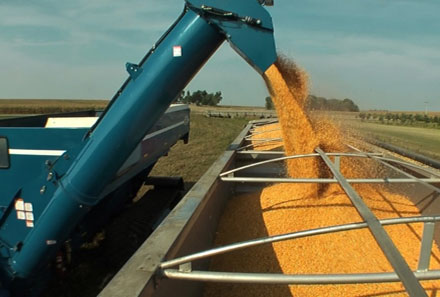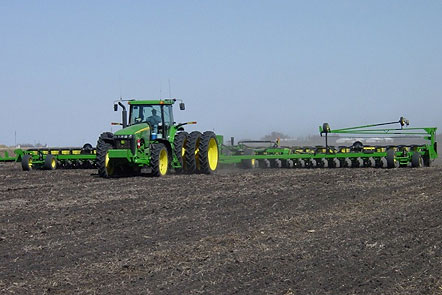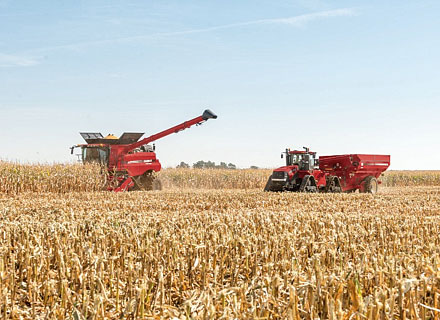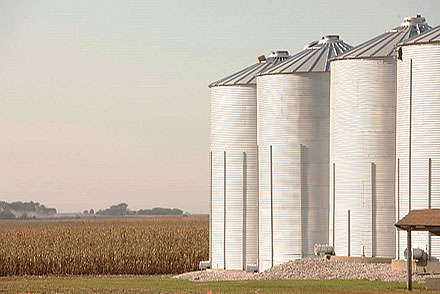Meeting Corn Grain Purity Standards for Specialty Markets
Crop Insights written by Steve Butzen¹ and Morrie Bryant²
Crop Insights written by Steve Butzen¹ and Morrie Bryant²
Growing corn for “specialty” or “niche” markets provides an enhanced income opportunity for farmers. The higher price commanded by these markets is due to the additional management and risk associated with producing specialty grains. Additional management is required to meet the purity standards of these markets while incurring the risk that if purity standards are not achieved, the crop may have to be marketed in traditional commodity channels with no pricing premium. Specific contractual obligations may present another layer of risk. This Crop Insights will discuss specialty corn markets (with particular focus on non-GMO markets), purity standards for these markets, and management practices to help achieve the purity requirements.

A corn hybrid containing a “biotech” or “transgenic” trait is often referred to as a “Genetically Modified Organism,” or “GMO.” Following their introduction in the mid-1990s, GMO hybrids were adopted by farmers at an unprecedented pace. Today, approximately 95 percent of the U.S. no. 2 yellow corn crop is grown utilizing biotech or transgenic traits. The remaining 5 percent of the crop, generally referred to now as the “conventional” or “non-GMO” corn market segment, has essentially morphed into a new niche market for corn.
Though non-GMO production is one of the newest niche market opportunities, specialty corn production is not a new concept; many farmers have contracted to produce white, waxy, or other specialty types for decades. In general, the principles of achieving purity standards for one type of specialty production apply to other types as well; however, non-GMO production presents some unique challenges. This is primarily because countries have imposed their own purity standards for non-GMO grain, and these standards differ significantly from one another. In addition, non-GMO production for export to the European Union has much more stringent purity requirements than other markets. Thus, the non-GMO market can be best thought of as a series of niche markets, each with its own unique purity requirements.
A key market for non-GMO corn has been and remains the Asian export market. Japan and Korea are important U.S. export customers for this grain. Both countries have GMO label laws in place that require notice on a product label of the presence of biotech traits. Many Japanese and Korean consumer product companies, particularly food companies, choose to source non-GMO corn in order to avoid putting such a notice on their products.
When non-GMO corn is originated in the United States, tolerance thresholds can be different based on the end user and the grain company acquiring the grain for export. Make sure you check on the threshold of tolerance for unintended or “adventitious presence” (AP) of biotech traits with your contract originator. Europe has the most restrictive standards for non-GMO corn, employing a 99.1% level of no detectable GMO traits, or a 0.9% threshold of tolerance for the adventitious presence of these traits.
A non-GMO domestic market also exists in the United States. There are growers and consumers alike who demand choice and prefer to not utilize biotech traits. The primary challenge in this market is that there is currently no standard definition of “non-GMO;” rather, it is typically whatever a particular market wants it to be. This ambiguity presents an obvious challenge for growers; if they fail to clearly understand how their particular market defines “non-GMO,” they could be disappointed when they deliver corn. This applies to all non-GMO production, not just production for U.S. markets.
Growers must know for certain if the threshold of tolerance for GMO traits is defined in the contract as 3%, 2%, 0.9%, or some other standard. Clearly understanding these “rules of engagement” is necessary to make the best possible decision about participating in the non-GMO market opportunity.
After carefully reviewing the purity standards mandated for the specialty crop being grown, producers must implement appropriate production practices to achieve those standards. This includes taking additional steps during planting, growing, and harvesting the crop and drying, storing, handling, and transporting the grain.
At planting, record-keeping, isolation, and equipment clean-out are the steps generally recommended to help ensure the grain ultimately meets required purity standards.
Record-keeping may be simple or sophisticated, depending on the technology available and grower expertise. As-planted (GPS-tagged) records that are transmitted in real time and backed up for safe-keeping are the most foolproof way to document planting. Electronic “notes” recorded on a smart phone or pad and also backed up in the cloud can be equally effective. Lastly, hand-written notes may still be adequate but lack the safety advantages inherent in backed-up electronic field records. Taking a picture of hand-written notes with a smart phone can lessen the risk of losing these records. Some contracts may require specific forms of documentation during the production of the specialty crop, including at planting. Be sure you are aware of any such contract requirements.

Isolation: Because corn is a cross-pollinated crop and its pollen is wind-dispersed, providing adequate isolation is at the very core of specialty corn production. In fact, the ability to sufficiently isolate the crop from other corn fields is often the deciding factor when considering specialty production. The degree of isolation required is, of course, closely tied to the level of purity targeted. For many end uses, the buyer will provide isolation guidelines to the grower. These guidelines will always take into account the distance and direction (upwind or downwind) of nearby corn fields and may also consider the type of corn (e.g., dent or sweet) in those fields. A commonly recommended isolation distance for some types of specialty corn production is 660 feet, but that distance could double when purity requirements are extremely high. Be sure to clearly understand the isolation distance needed to achieve your desired level of purity.
Inadequate isolation distance can often be overcome by using a number of rows of the specialty crop as a “buffer,” segregating the buffer grain at harvest, and selling it as commodity grain if it does not meet the purity standards. “Time isolation” can effectively add to distance isolation. Time isolation involves staggering the planting dates of the specialty and nearby corn to create a pollination “differential.” This practice may be risky if employed as the primary means of isolation, as crop pollination timing interacts with the growing environment and is not completely predictable.
Equipment Cleanout at Planting: A basic tenet of specialty corn production is cleaning equipment to remove kernels of contaminating (non-specialty) seeds and grain. Planters are reservoirs for contaminating seeds of previously planted hybrids. Each make of planter is different, but a thorough cleaning usually involves removing seeds from each individual seed metering unit in addition to the seed hopper(s). The planter owner’s manual should provide tips on proper cleanout procedures, which may also be available online. Growers may also want to check for any videos demonstrating planter cleanout at youtube.com or other websites. Seed tenders, including the box and auger, must also be cleaned to prevent mixing or commingling of seeds.
In most cases, there are no visual differences between corn hybrid plants, whether they are GMO, non-GMO, or any number of other specialty grain types. That makes it difficult or impossible to identify and destroy unwanted plants prior to harvest. Thus, all possible steps should be taken to prevent possible inclusion of off-type seeds at or prior to planting.
Some unwanted plants in a specialty corn field are not sourced from the planting equipment; rather, they are volunteer corn plants from ears or grain left in the field from previous crops. When volunteer plants grow from a dropped ear of corn, they usually grow in a thick bunch that precludes the development of grain on any of the volunteer plants. However, tassels may be produced on some plants, leading to pollen mixing with the new crop. Just like pollen drifting in from a nearby field, this pollen mixing would reduce the purity of the specialty grain. Thus, all measures should be taken to prevent volunteer corn in a specialty crop, including timely harvest of preceding corn, rotation away from corn, and use of tillage or herbicides when appropriate.

Photo courtesy of CNH.
Harvest presents an opportunity to increase the purity of the specialty crop, as well as a risk of decreasing it. Harvesting a number of “border” or “buffer” rows from the perimeter of the field and segregating that grain can increase the purity level in the remainder of the field. For example, harvesting 16 to 24 rows from the windward (usually south or west) side of a field may be recommended when there is a corn field nearby in that direction, especially if the isolation distance is at or below the suggested minimum.
The risk of decreasing crop purity comes from the chance that significant off-type grain is still present in the combine, grain cart or truck. Inspecting and cleaning the grain cart, or truck is a rather simple and basic process; doing the same for the combine is significantly more complex.
Combine Cleanout: If the combine has been thoroughly cleaned before storing the previous winter, harvesting the specialty field before any others can save a cleaning. Otherwise, additional steps are likely needed; studies have shown that as much as one to two bushels of grain may remain in the combine, even after running the unloading auger empty for a full minute.
The first step in combine cleanout is to determine what level of purity is needed. For some grain uses, simply “flushing” the existing grain will be adequate. This is accomplished by harvesting a load or partial load of the specialty hybrid and using that load for commodity grain. While negating any premium opportunities for those bushels, this method of cleanout may still be much more cost-effective than labor-intensive cleanout procedures.
Some types of specialty production (e.g., non-GMO production for European markets) may require a more thorough combine cleaning. Details for systematically cleaning the entire combine vary by brand and model. Consult your operator’s manual for manufacturer instructions, or search for instructions or videos online. Then follow a systematic plan to clean specific areas in the machine, usually going from top to bottom and entry to exit. Be sure to conduct cleanout procedures with the utmost safety in mind, including blocking the head and removing the key when workers will be in harm’s way. Cleanout may involve running the machine one or more times during the process; be sure all workers are clear of the machine.

Clean dryers and grain bins thoroughly of all residual grain. Growers generally do a good job of cleaning these areas between crops, such as corn and soybeans. Applying the same discipline to cleaning between commodity and specialty production may be needed to meet purity standards for some grain uses. In addition to cleaning, labeling and record-keeping is important to maintain the identity of grain in storage. Clearly document the hybrid, cleaning procedures, and other information according to the intended end use or contract requirements.
The existing commodity grain handling system is designed to store, transport, and distribute billions of bushels of crops. Growers, grain handlers, and processors did not have special segregation of crops in mind when they built bulk-handling systems. Consequently, there are numerous ways that adventitious presence may occur during grain handling and transport. Commonly referred to as "mechanical mixing" or "commingling", these include mixing of grain during harvesting, handling (conveying systems), or hauling, or in processing equipment or storage facilities.
Conveying Systems: Auger and elevator contamination can be minimized by allowing conveying systems to run empty between loads of different grain types. Also, the auger sump, or pit, should be emptied of residual grain. If additional purity is needed, this can be followed by flushing the system with the new grain and placing the flushed grain in a mixed grain bin.
Grain Cart/Trucks: Clean all obvious surfaces where grain may reside, including horizontal ridges inside of the grain cart. The vertical auger sump in grain carts may have a cleanout shield at base.
1Steve Butzen, Agronomy Information Consultant
2Morrie Bryant, Former Sr. Marketing Manager
August 2015; Reviewed October 2019
The foregoing is provided for informational use only. Contact your Pioneer sales professional for information and suggestions specific to your operation. Product performance is variable and subject to any number of environmental, disease, and pest pressures. Individual results may vary. Pioneer® brand products are provided subject to the terms and conditions of purchase which are part of the labeling and purchase documents.